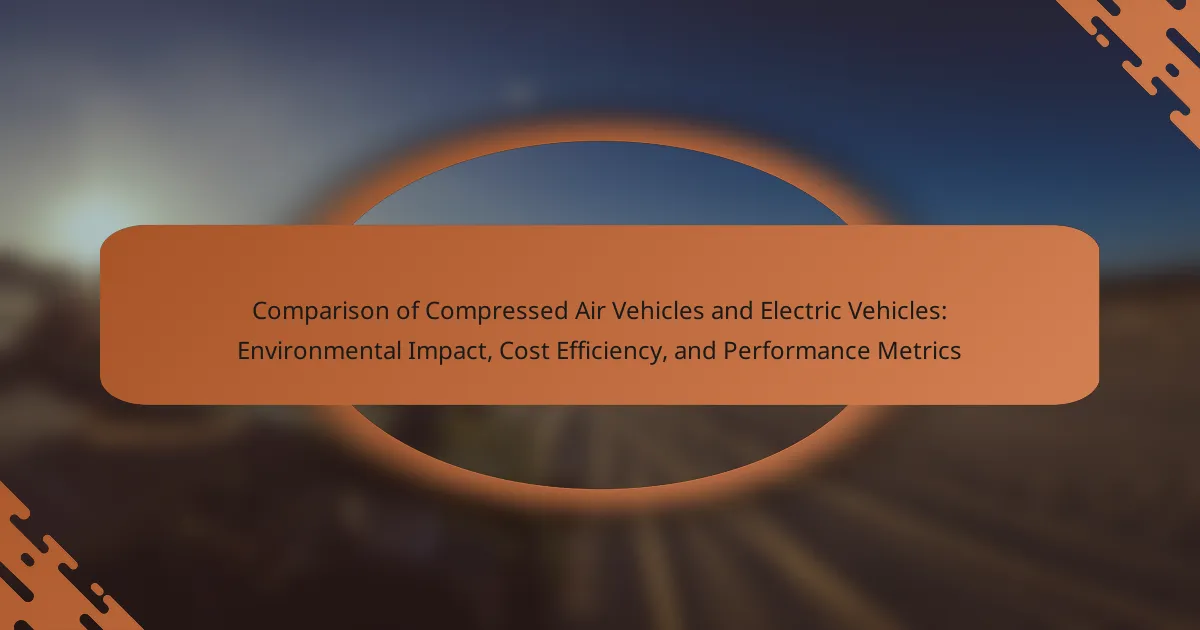Compressed Air Vehicles (CAVs) and Electric Vehicles (EVs) are two innovative transportation technologies aimed at reducing fossil fuel reliance. CAVs utilize compressed air stored in tanks to power their operation, resulting in zero emissions, while EVs rely on electricity from batteries, which can lead to indirect emissions depending on the energy source. This article compares the environmental impact, cost efficiency, and performance metrics of both vehicle types. Key aspects include lifecycle emissions, manufacturing costs, operational expenses, and performance capabilities such as speed, range, and acceleration. Understanding these factors can inform consumers and policymakers about the sustainability and viability of CAVs and EVs in the context of modern transportation.
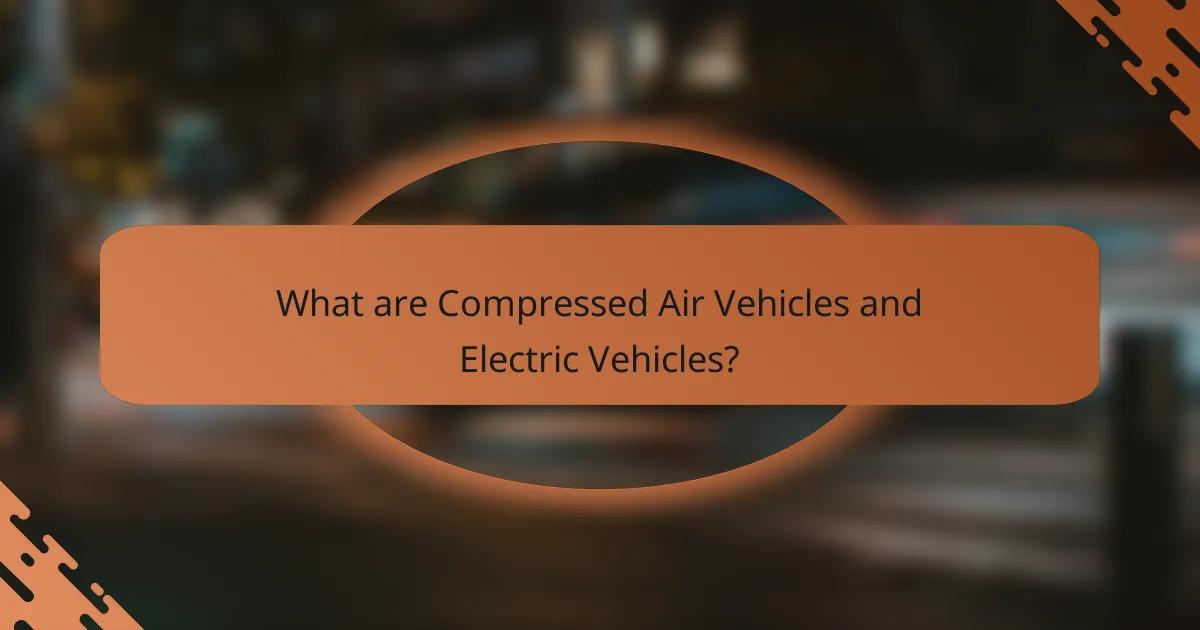
What are Compressed Air Vehicles and Electric Vehicles?
Compressed Air Vehicles (CAVs) are vehicles powered by compressed air stored in tanks. They operate by releasing the compressed air to drive pistons or turbines, converting air pressure into mechanical energy. CAVs produce zero emissions during operation, making them environmentally friendly.
Electric Vehicles (EVs) are powered by electricity stored in batteries. They use electric motors to drive the wheels, resulting in high efficiency and low emissions. EVs can be charged at home or public charging stations, contributing to their convenience.
Both vehicle types aim to reduce reliance on fossil fuels. CAVs utilize renewable energy sources for air compression, while EVs can be charged using renewable energy. The development of both technologies reflects a shift towards sustainable transportation solutions.
How do Compressed Air Vehicles operate compared to Electric Vehicles?
Compressed Air Vehicles (CAVs) operate by utilizing compressed air stored in tanks to drive pistons that power the vehicle. This method relies on the expansion of compressed air to create mechanical energy. In contrast, Electric Vehicles (EVs) use electric motors powered by batteries to convert electrical energy into motion. CAVs release no emissions during operation, making them environmentally friendly. EVs also produce zero tailpipe emissions but have a carbon footprint associated with electricity generation. CAVs generally have a shorter range compared to EVs, which can often travel further on a single charge. Refueling CAVs is quick, taking only a few minutes, while EVs require longer charging times. The efficiency of CAVs can be lower than that of EVs, as energy loss occurs during air compression and expansion. EVs typically offer higher efficiency due to direct conversion of electricity into motion.
What are the key components of Compressed Air Vehicles?
The key components of compressed air vehicles include the air storage tank, compressor, pneumatic motor, and control system. The air storage tank holds compressed air, providing energy for propulsion. The compressor is responsible for compressing ambient air to the required pressure. The pneumatic motor converts the energy from compressed air into mechanical energy for movement. The control system regulates the flow of air and manages vehicle operations. Each component plays a crucial role in the vehicle’s functionality and efficiency.
What are the key components of Electric Vehicles?
The key components of electric vehicles (EVs) include the electric motor, battery pack, and power electronics. The electric motor converts electrical energy into mechanical energy to drive the vehicle. The battery pack stores electrical energy, typically using lithium-ion technology, providing the necessary power for operation. Power electronics manage the flow of electrical energy between the battery and motor, ensuring efficient performance. Additionally, EVs have regenerative braking systems that recover energy during braking. Together, these components enable electric vehicles to operate efficiently and sustainably.
What are the primary uses of Compressed Air Vehicles and Electric Vehicles?
Compressed Air Vehicles (CAVs) primarily use compressed air as a power source for propulsion. They are often utilized in urban environments for short-distance travel. CAVs are designed for low-speed applications, making them suitable for city commuting and local deliveries. Electric Vehicles (EVs) primarily use electricity stored in batteries as their power source. They are widely used for personal transportation, public transit, and commercial applications. EVs are suitable for longer distances and offer higher speeds compared to CAVs. Both vehicle types contribute to reducing greenhouse gas emissions compared to traditional fossil fuel vehicles.
In which sectors are Compressed Air Vehicles most commonly utilized?
Compressed Air Vehicles are most commonly utilized in the transportation and logistics sectors. These vehicles are used for short-distance deliveries and urban transportation. Their design allows for efficient operation in confined spaces. Additionally, they are employed in industrial applications for material handling. The automotive industry also explores compressed air technology for prototype development. Furthermore, these vehicles are considered for public transport solutions in urban areas. Their low emissions align with environmental regulations and sustainability goals.
In which sectors are Electric Vehicles most commonly utilized?
Electric vehicles are most commonly utilized in the transportation, logistics, and public transit sectors. In transportation, personal electric vehicles are increasingly popular among consumers. The logistics sector uses electric delivery vans and trucks to reduce emissions. Public transit agencies are adopting electric buses to enhance sustainability. The growing demand for electric vehicles is driven by advancements in battery technology. Many cities are implementing policies to promote electric vehicle use. These sectors are prioritizing electric vehicles to meet environmental goals.
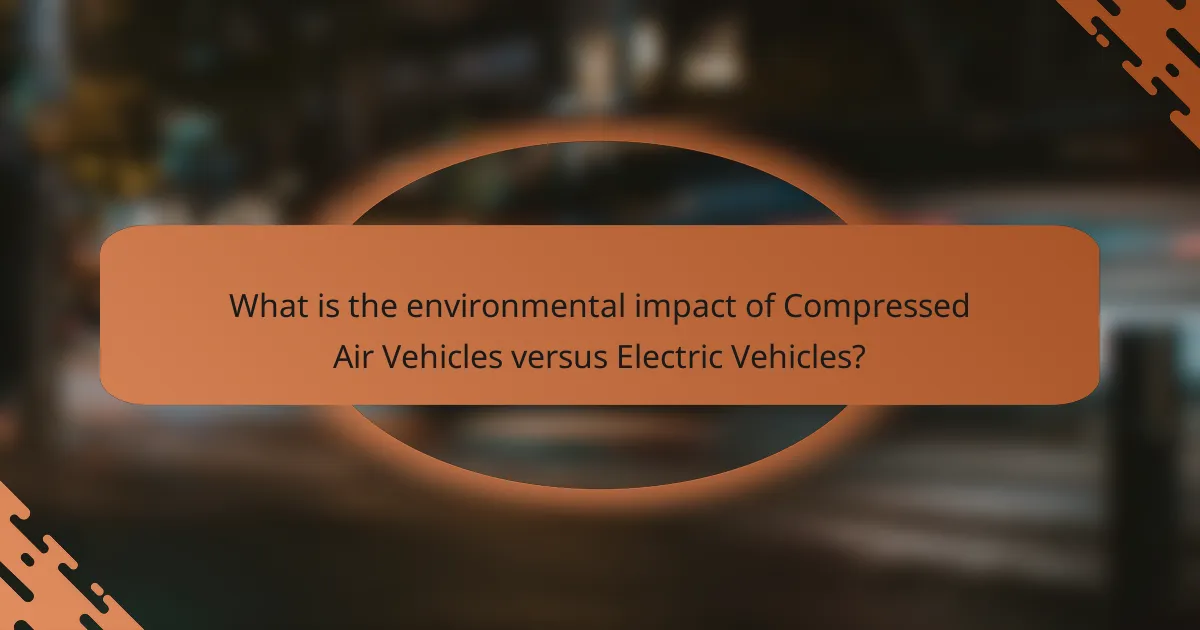
What is the environmental impact of Compressed Air Vehicles versus Electric Vehicles?
Compressed Air Vehicles (CAVs) generally have a lower environmental impact compared to Electric Vehicles (EVs) in terms of emissions during operation. CAVs use compressed air as a power source, resulting in zero tailpipe emissions. In contrast, EVs rely on electricity, which can be generated from fossil fuels, leading to indirect emissions. The production of EV batteries also contributes to environmental degradation due to mining activities for lithium and cobalt.
According to a study by the International Council on Clean Transportation, EVs may produce significant lifecycle emissions, especially if charged from non-renewable energy sources. CAVs, however, primarily depend on renewable energy for air compression, making them potentially more sustainable.
CAVs also have a smaller carbon footprint during manufacturing compared to the complex battery systems of EVs. The energy efficiency of CAVs is higher in urban environments due to their lightweight design. Overall, while both technologies aim to reduce reliance on fossil fuels, CAVs currently present a more environmentally friendly option with fewer emissions throughout their lifecycle.
How do the emissions from Compressed Air Vehicles compare to those from Electric Vehicles?
Compressed Air Vehicles (CAVs) generally produce lower emissions compared to Electric Vehicles (EVs) during operation. CAVs emit no greenhouse gases while driving, as they rely on compressed air for propulsion. However, the overall emissions depend on the source of the compressed air. If the air is compressed using renewable energy, emissions remain minimal. In contrast, EVs produce no tailpipe emissions but have indirect emissions based on the electricity source used for charging. According to the U.S. Department of Energy, the lifecycle emissions of EVs can vary significantly based on regional energy mixes. In regions reliant on fossil fuels, EVs may have higher overall emissions than CAVs. Thus, while CAVs are cleaner in operation, the environmental impact of both depends on energy sourcing.
What are the lifecycle emissions of each vehicle type?
Lifecycle emissions vary significantly among vehicle types. Compressed air vehicles (CAVs) typically emit around 20 grams of CO2 per kilometer. This low emission is due to their reliance on compressed air for propulsion. Electric vehicles (EVs) have lifecycle emissions ranging from 30 to 150 grams of CO2 per kilometer. The variation depends on the energy source used for electricity generation. For instance, EVs charged from renewable sources have lower emissions. In contrast, those charged from fossil fuels exhibit higher emissions. These figures are derived from comprehensive lifecycle assessments that consider manufacturing, operation, and end-of-life processes.
How do energy sources for charging Electric Vehicles impact their environmental footprint?
Energy sources for charging Electric Vehicles (EVs) significantly influence their environmental footprint. The environmental impact varies based on the source of electricity used for charging. Renewable energy sources, such as solar, wind, and hydroelectric power, result in lower emissions. Studies indicate that EVs charged with renewable energy can reduce greenhouse gas emissions by up to 70%. Conversely, charging from fossil fuel-based sources, like coal or natural gas, increases emissions. Research shows that charging EVs using coal can emit as much CO2 as conventional gasoline vehicles. The overall environmental footprint of EVs is thus contingent on the energy mix of the grid. Transitioning to cleaner energy sources can enhance the sustainability of electric mobility.
What are the sustainability advantages of each vehicle type?
Compressed air vehicles (CAVs) offer sustainability advantages by producing zero emissions during operation. They utilize compressed air as fuel, which can be generated from renewable energy sources. This reduces reliance on fossil fuels and lowers greenhouse gas emissions. Additionally, CAVs have a lower carbon footprint in manufacturing compared to electric vehicles.
Electric vehicles (EVs) also provide sustainability benefits through reduced tailpipe emissions. EVs can be powered by renewable energy, significantly decreasing their overall environmental impact. The efficiency of electric motors contributes to lower energy consumption per mile. Furthermore, advancements in battery recycling are improving the sustainability of EVs over their lifecycle.
Both vehicle types contribute to cleaner air and a reduction in urban pollution. Their adoption supports global efforts to combat climate change.
How do Compressed Air Vehicles promote sustainability?
Compressed Air Vehicles promote sustainability by utilizing compressed air as a clean energy source. They emit no harmful pollutants during operation, contributing to improved air quality. Unlike traditional fossil fuel vehicles, they reduce greenhouse gas emissions. Compressed air technology also decreases reliance on non-renewable energy sources. Research indicates that these vehicles can operate with minimal energy consumption compared to gasoline engines. Additionally, they can be powered by renewable energy sources, further enhancing their sustainability profile. This innovative approach supports the transition to greener transportation solutions.
How do Electric Vehicles contribute to sustainable transportation?
Electric vehicles (EVs) contribute to sustainable transportation by reducing greenhouse gas emissions. They produce zero tailpipe emissions, unlike conventional vehicles that rely on fossil fuels. According to the U.S. Environmental Protection Agency, EVs can reduce carbon dioxide emissions by up to 60% compared to gasoline-powered cars. Additionally, EVs can be powered by renewable energy sources, further decreasing their environmental impact. The International Energy Agency reports that the growth of EVs can significantly lower global oil demand. This transition supports cleaner air quality in urban areas, promoting public health. Furthermore, advancements in battery technology enhance energy efficiency, making EVs a viable option for sustainable mobility.
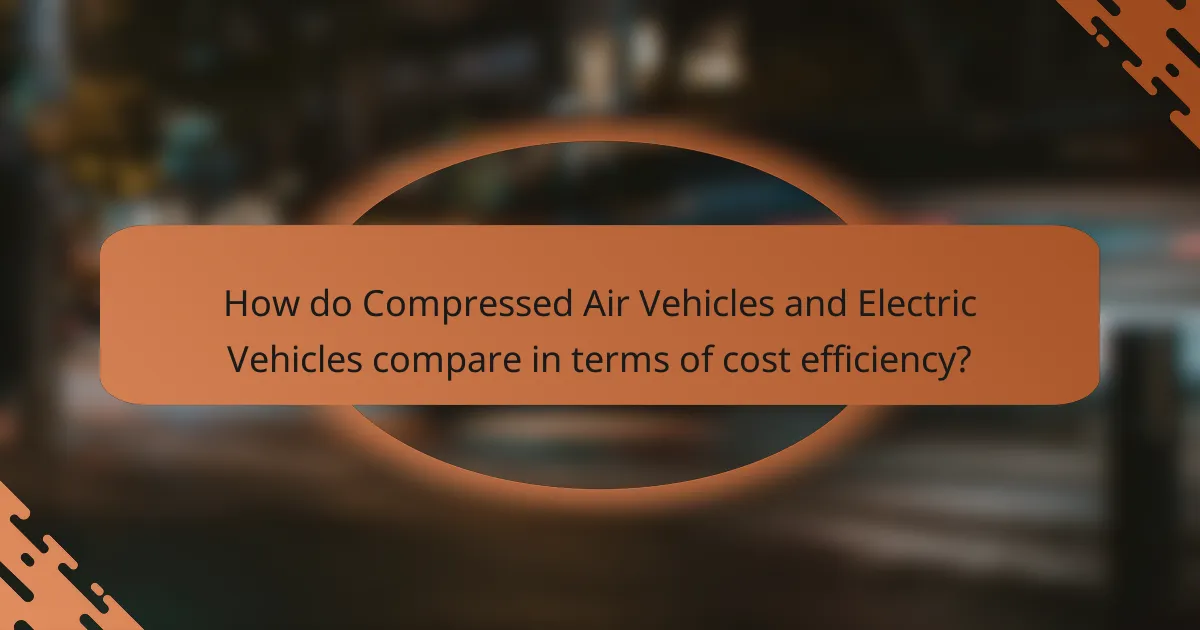
How do Compressed Air Vehicles and Electric Vehicles compare in terms of cost efficiency?
Compressed Air Vehicles (CAVs) typically have lower initial costs compared to Electric Vehicles (EVs). CAVs can be cheaper to manufacture due to simpler components and lower battery costs. However, operational costs for CAVs can be higher due to the energy required for compression. In contrast, EVs benefit from lower electricity costs and fewer moving parts, leading to reduced maintenance expenses. Studies show that the total cost of ownership for EVs often becomes more favorable over time, especially with advancements in battery technology. Additionally, government incentives for EV adoption can further enhance their cost efficiency.
What are the initial purchase costs of Compressed Air Vehicles and Electric Vehicles?
The initial purchase costs of Compressed Air Vehicles (CAVs) typically range from $10,000 to $20,000. In contrast, Electric Vehicles (EVs) generally have higher initial costs, ranging from $30,000 to $60,000. CAVs are often more affordable due to simpler technology and fewer components. EVs, while more expensive, offer advanced features and longer ranges. The price difference reflects the varying levels of technology and market demand. CAVs are still emerging in the market, which influences their pricing. EVs benefit from established production and incentives, impacting their costs.
How do maintenance costs differ between the two vehicle types?
Maintenance costs for compressed air vehicles (CAVs) are generally lower than those for electric vehicles (EVs). CAVs have fewer moving parts and do not require complex battery systems. This simplicity leads to reduced wear and tear, which minimizes maintenance frequency and costs. In contrast, EVs often incur higher expenses due to battery maintenance and replacement. Battery packs in EVs can cost between $5,000 to $15,000 to replace, depending on the model. Additionally, EVs require regular software updates and specialized servicing, which can add to the overall maintenance costs. Therefore, the maintenance cost advantage of CAVs over EVs is significant, primarily due to their simpler mechanical systems and lower component replacement needs.
What are the operational costs associated with each vehicle type?
Compressed air vehicles typically have lower operational costs compared to electric vehicles. Compressed air vehicles benefit from inexpensive energy sources for refueling. The cost of compressed air is significantly lower than electricity per mile driven. Maintenance costs for compressed air vehicles are often lower due to fewer moving parts. Electric vehicles, on the other hand, incur higher costs related to battery maintenance and replacement. The average cost of electricity for electric vehicle charging can vary, but generally, it is higher than the cost of compressed air. According to the U.S. Department of Energy, electric vehicle owners can expect to spend about 3 to 5 cents per mile on electricity. This contrasts with compressed air vehicles, which can operate at about 1 to 2 cents per mile. Thus, compressed air vehicles present a more cost-effective option in terms of operational expenses.
What incentives exist for purchasing Compressed Air Vehicles and Electric Vehicles?
Incentives for purchasing Compressed Air Vehicles (CAVs) and Electric Vehicles (EVs) include government subsidies, tax credits, and rebates. Many governments offer financial incentives to promote cleaner transportation options. For instance, in the United States, federal tax credits for EVs can be as high as $7,500. Some states provide additional rebates or incentives for both CAVs and EVs.
CAVs may qualify for specific incentives aimed at reducing air pollution. These vehicles often have lower operating costs due to reduced fuel expenses. EVs typically have lower maintenance costs because they have fewer moving parts.
Furthermore, both vehicle types may benefit from access to carpool lanes or reduced tolls in certain regions. These incentives encourage consumers to transition to more sustainable vehicle options. The increased adoption of CAVs and EVs contributes to reduced greenhouse gas emissions and improved air quality.
What government subsidies or tax credits are available for Electric Vehicles?
Federal tax credits for electric vehicles (EVs) include the Qualified Plug-in Electric Drive Motor Vehicle Credit. This credit can provide up to $7,500 depending on the vehicle’s battery capacity. Additionally, some states offer their own incentives, such as rebates or tax credits. These state incentives vary widely and can range from a few hundred to several thousand dollars. Local utility companies may also provide rebates for EV charging installations. The availability of these subsidies is intended to encourage the adoption of electric vehicles and reduce greenhouse gas emissions.
Are there similar incentives for Compressed Air Vehicles?
Currently, there are limited incentives specifically for Compressed Air Vehicles (CAVs). Unlike electric vehicles (EVs), which often receive tax credits and rebates, CAVs do not have widespread government support. This lack of incentives can be attributed to the nascent stage of CAV technology and infrastructure.
In some regions, experimental programs may provide funding or support for research into CAVs. However, these are not as established or extensive as those for EVs. For example, the European Union has shown interest in various alternative fuel vehicles, but specific incentives for CAVs remain sparse.
Overall, the landscape for CAV incentives is not as developed as that for electric vehicles, limiting their market growth and adoption.
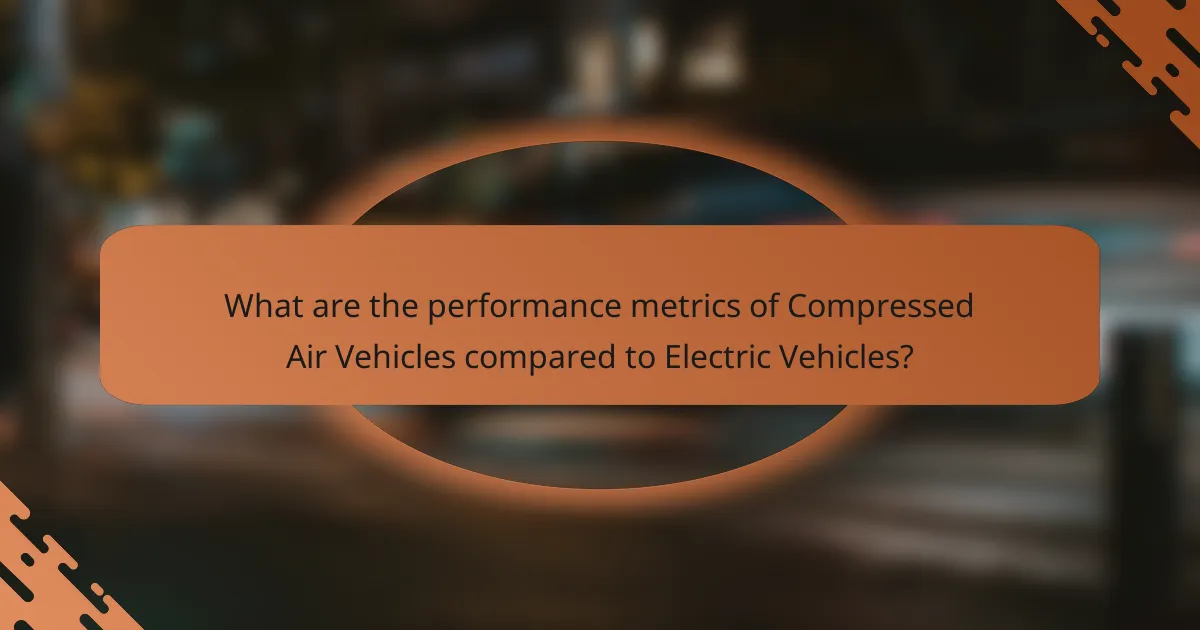
What are the performance metrics of Compressed Air Vehicles compared to Electric Vehicles?
Compressed Air Vehicles (CAVs) typically have lower performance metrics compared to Electric Vehicles (EVs). CAVs generally achieve a maximum speed of around 70 mph. In contrast, EVs can reach speeds exceeding 150 mph.
The range of CAVs is limited to approximately 100 miles on a full charge. EVs can cover over 300 miles with a single charge. CAVs take longer to refuel, requiring around 3-4 hours for a full tank. EVs can be charged in as little as 30 minutes with fast chargers.
Acceleration in CAVs is slower, usually taking over 10 seconds to reach 60 mph. EVs can often achieve this in under 4 seconds. Additionally, CAVs produce less torque, which affects their overall performance. EVs provide instant torque, enhancing driving experience and responsiveness.
These performance differences highlight the advantages of EVs in speed, range, and efficiency over CAVs.
How do the range and efficiency of Compressed Air Vehicles compare to Electric Vehicles?
Compressed Air Vehicles (CAVs) generally have a shorter range and lower efficiency compared to Electric Vehicles (EVs). CAVs typically achieve a range of 100 to 200 miles on a full tank of compressed air. In contrast, EVs can often exceed 300 miles on a single charge. The efficiency of CAVs is also lower, with energy conversion rates around 30%. EVs, on the other hand, can have energy conversion efficiencies above 90%. This means that EVs utilize a greater portion of their energy source for actual driving. The performance metrics highlight that EVs provide superior range and efficiency, making them more practical for everyday use.
What is the average range of Compressed Air Vehicles?
The average range of compressed air vehicles is typically between 100 to 200 kilometers. This range can vary based on the vehicle’s design and the efficiency of its compressed air storage system. For instance, some prototypes have demonstrated ranges exceeding 200 kilometers under optimal conditions. Research indicates that the efficiency of air compression and vehicle weight significantly influences the achievable distance.
What is the average range of Electric Vehicles?
The average range of electric vehicles is typically between 150 to 300 miles on a single charge. This range can vary significantly based on the vehicle model and battery capacity. For example, some high-end models can exceed 400 miles. According to the U.S. Department of Energy, the average electric vehicle range has been steadily increasing due to advancements in battery technology. In 2021, the average range for new electric vehicles sold was about 234 miles. This improvement reflects ongoing innovations in electric vehicle design and efficiency.
How do acceleration and speed metrics differ between the two vehicle types?
Compressed air vehicles (CAVs) typically have slower acceleration and lower top speeds compared to electric vehicles (EVs). CAVs can accelerate from 0 to 60 mph in approximately 10 to 12 seconds. In contrast, many EVs achieve this in under 4 seconds. The top speed of CAVs is often limited to around 70 mph due to design constraints. EVs, however, can reach speeds exceeding 150 mph. The differences arise from the energy delivery systems; EVs utilize high-torque electric motors for rapid acceleration. CAVs rely on compressed air, which provides less immediate power. This distinction in power sources and engineering leads to significant performance differences in acceleration and speed metrics.
What are the acceleration capabilities of Compressed Air Vehicles?
Compressed Air Vehicles (CAVs) typically demonstrate acceleration capabilities ranging from 0 to 60 mph in approximately 10 to 15 seconds. This performance is influenced by the design and efficiency of the air propulsion system. CAVs utilize compressed air to generate thrust, which can be less powerful than traditional combustion engines. The acceleration rate can vary based on factors such as vehicle weight and air tank pressure. For example, the AirPod, a prototype CAV, can reach 0 to 60 mph in about 8 seconds under optimal conditions. This places CAVs in a competitive position with electric vehicles, though generally, they may lag behind in achieving higher acceleration rates.
What are the acceleration capabilities of Electric Vehicles?
Electric vehicles (EVs) can achieve rapid acceleration due to their electric motors. These motors provide instant torque, allowing EVs to accelerate quickly from a standstill. For example, many electric cars can go from 0 to 60 mph in under 4 seconds. High-performance models, like the Tesla Model S Plaid, can reach 60 mph in just 1.99 seconds. This capability is attributed to the efficient power delivery of electric drivetrains. Additionally, the low center of gravity from battery placement enhances stability during acceleration. Overall, EVs demonstrate superior acceleration compared to traditional internal combustion engine vehicles.
What are the safety performance ratings of each vehicle type?
Safety performance ratings vary by vehicle type. Compressed air vehicles generally have lower safety ratings due to limited crash testing. Electric vehicles often receive higher safety ratings. This is due to advanced safety features and robust designs. For instance, many electric vehicles have top ratings from organizations like the IIHS and NHTSA. These ratings reflect performance in crash tests and safety technology. Specific ratings can vary by model and manufacturer. Therefore, it’s essential to review individual vehicle ratings for accurate comparisons.
How do Compressed Air Vehicles perform in crash tests?
Compressed Air Vehicles (CAVs) generally perform adequately in crash tests, but specific results vary by design. CAVs utilize lightweight materials, which can affect their crashworthiness. Testing has shown that their structural integrity can be compromised in high-impact scenarios. However, some CAV models have demonstrated compliance with safety standards set by organizations like the National Highway Traffic Safety Administration. For example, crash tests conducted on prototypes have revealed a moderate level of occupant protection. The use of compressed air as a propulsion method does not inherently enhance or diminish crash performance compared to conventional vehicles. Overall, ongoing research aims to improve safety features in CAV designs.
How do Electric Vehicles perform in crash tests?
Electric vehicles (EVs) generally perform well in crash tests. Many EV models receive high safety ratings from organizations like the National Highway Traffic Safety Administration (NHTSA) and the Insurance Institute for Highway Safety (IIHS). For instance, the Tesla Model 3 achieved a five-star overall safety rating from NHTSA. EVs often have a low center of gravity, which can reduce the risk of rollovers. Additionally, the absence of a traditional engine allows for more crumple zone space, enhancing passenger protection. Battery placement in EVs also contributes to structural integrity during impacts. Overall, EVs are designed with safety as a priority, leading to strong crash test performances.
What practical considerations should consumers keep in mind when choosing between these vehicle types?
Consumers should consider cost, range, maintenance, and environmental impact when choosing between compressed air vehicles and electric vehicles. Compressed air vehicles generally have lower initial costs compared to electric vehicles. However, electric vehicles often provide a longer driving range on a single charge. Maintenance costs for electric vehicles can be lower due to fewer moving parts. In contrast, compressed air vehicles may require more frequent maintenance due to the complexity of air compression systems. Environmental impact varies; electric vehicles can produce zero emissions during operation, while compressed air vehicles depend on the source of electricity used for air compression. Therefore, consumers should evaluate their driving needs, budget, and environmental priorities before making a decision.
The main entity of this article is the comparison between Compressed Air Vehicles (CAVs) and Electric Vehicles (EVs). The article provides a detailed examination of their environmental impact, cost efficiency, and performance metrics. It highlights the operational differences, including emissions, lifecycle costs, and the key components of each vehicle type. Additionally, the article discusses the practicality of each option based on factors such as range, acceleration, and safety performance ratings, assisting consumers in making informed decisions regarding sustainable transportation choices.
